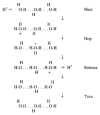Humidity sensors principle, mechanism, and fabrication technologies: a comprehensive review
- PMID: 24784036
- PMCID: PMC4063076
- DOI: 10.3390/s140507881
Humidity sensors principle, mechanism, and fabrication technologies: a comprehensive review
Abstract
Humidity measurement is one of the most significant issues in various areas of applications such as instrumentation, automated systems, agriculture, climatology and GIS. Numerous sorts of humidity sensors fabricated and developed for industrial and laboratory applications are reviewed and presented in this article. The survey frequently concentrates on the RH sensors based upon their organic and inorganic functional materials, e.g., porous ceramics (semiconductors), polymers, ceramic/polymer and electrolytes, as well as conduction mechanism and fabrication technologies. A significant aim of this review is to provide a distinct categorization pursuant to state of the art humidity sensor types, principles of work, sensing substances, transduction mechanisms, and production technologies. Furthermore, performance characteristics of the different humidity sensors such as electrical and statistical data will be detailed and gives an added value to the report. By comparison of overall prospects of the sensors it was revealed that there are still drawbacks as to efficiency of sensing elements and conduction values. The flexibility offered by thick film and thin film processes either in the preparation of materials or in the choice of shape and size of the sensor structure provides advantages over other technologies. These ceramic sensors show faster response than other types.
Figures










References
-
- Dai C.-L., Liu M.-C., Chen F.-S., Wu C.-C., Chang M.-W. A Nanowire WO3 Humidity Sensor Integrated with Micro-Heater and Inverting Amplifier Circuit on Chip Manufactured Using CMOS-MEMS Technique. Sens. Actuators B Chem. 2007;123:896–901.
-
- Boltshauser T., Schonholzer M., Brand O., Baltes H. Resonant Humidity Sensors Using Industrial CMOS-Technology Combined with Postprocessing. J. Micromech. Microeng. 1992;2:205–207.
-
- Okcan B., Akin T. A Low-Power Robust Humidity Sensor in a Standard CMOS Process. IEEE Trans. Electron Devices. 2007;54:3071–3078.
-
- Oprea A., Courbat J., Bârsan N., Briand D., de Rooij N.F., Weimar U. Temper wer Applications. Sens. Actuators B Chem. 2009;140:227–232.
Publication types
MeSH terms
Substances
LinkOut - more resources
Full Text Sources
Other Literature Sources

